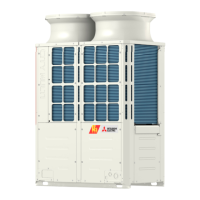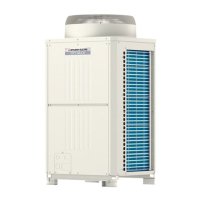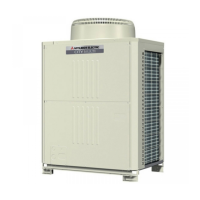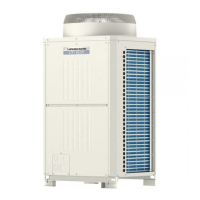What to do if my Mitsubishi Electric PURY-P600 has a drain pump abnormality?
- NNicole WhiteAug 28, 2025
If your Mitsubishi Electric Air Conditioner is showing a drain pump abnormality, check Code List 2502.

What to do if my Mitsubishi Electric PURY-P600 has a drain pump abnormality?
If your Mitsubishi Electric Air Conditioner is showing a drain pump abnormality, check Code List 2502.
What to do if my Mitsubishi Electric Air Conditioner displays a thermal sensor abnormality?
If your Mitsubishi Electric Air Conditioner shows a thermal sensor abnormality, check Code List 5101.
What to do if my Mitsubishi Electric PURY-P600 shows fan speed abnormality (motor abnormality) (IC, LC)?
If you're encountering a fan speed abnormality (motor abnormality) (IC, LC) with your Mitsubishi Electric Air Conditioner, check Code List 4116.
What to do if my Mitsubishi Electric PURY-P600 Air Conditioner is leaking water (LC)?
If you are experiencing water leakage (LC) with your Mitsubishi Electric Air Conditioner, check Code List 2600.
What to do if my Mitsubishi Electric PURY-P600 has a water leakage abnormality?
If you notice a water leakage abnormality with your Mitsubishi Electric Air Conditioner, check Code List 2500.
| Brand | Mitsubishi Electric |
|---|---|
| Model | PURY-P600 |
| Category | Air Conditioner |
| Language | English |
Essential items, tools, materials, and piping preparations before servicing.
Notes on changing refrigerant, leaks, characteristics, and oil.
Guidelines for electrical work, M-NET control, cable types, and system connection examples.
Specifies limitations on refrigerant piping lengths and configurations.
Visual identification of outdoor unit components and refrigerant circuit layout.
Visual representation of the control box and its internal components.
View of components located under the circuit board cover.
Detailed views and labeling of the main, inverter, and fan control boards.
Detailed views and labeling of relay, filter, and gate amplifier boards.
Front view of the BC controller, showing key components.
Rear view of the BC controller, showing key components.
Exterior view of the BC control box and detailed view of the BC controller board.
Comparison of functions, specifications, and selection criteria for MA and ME remote controllers.
Procedures for group settings and interlocking LOSSNAY with indoor units on ME controller.
Procedures for interlocking LOSSNAY with indoor units using MA remote controller.
How to select the temperature detection source for indoor units.
Electrical wiring diagram for specific outdoor unit models.
Electrical wiring diagram for specific outdoor unit models.
Electrical wiring diagrams for various BC controller models.
Diagrams illustrating the refrigerant flow for different models and BC controllers.
Explains the functions of key components in the outdoor, indoor, and BC controller units.
Configuration of dip switches on outdoor, indoor, and BC controller boards.
Configuration of switches on the MA remote controller.
Steps for initial control, start-up, and compressor frequency settings.
Operation of bypass solenoid valves (SV1, SV2, SV3) for pressure control.
How compressor frequency is controlled based on capacity and conditions.
Compressor operation modes, pressure, and temperature limits.
Initiation, completion, and problem handling for defrost operation.
Conditions and steps for initiating and performing refrigerant recovery.
Control methods for the outdoor unit fan's speed and operation.
Overview of operation modes for indoor/outdoor units and auto changeover.
Control logic for solenoid valves (SVA, SVB, SVC, SVM) and LEV based on operation mode.
How to set up and operate demand control using DIP switches and external inputs.
Flowchart for determining the operation mode of indoor units.
Flowchart for determining outdoor unit operation modes.
Flowchart for BC controller operation modes.
Essential checks to perform before starting the test run.
Step-by-step instructions for conducting the test run using the remote controller.
Relationship between operating characteristics and refrigerant amount.
Symptoms, volume judgment, and adjustment procedures for refrigerant.
Method for calculating the amount of refrigerant to add for extension pipes.
Steps for entering and performing refrigerant volume adjustment mode.
Identifies symptoms that do not indicate a problem during normal operation.
Reference data for standard cooling operation conditions by model.
Reference data for standard heating operation conditions by model.
List of error codes and their corresponding check contents.
Guidance on how to respond to error messages displayed on the remote controller.
Troubleshooting steps for mechanical issues identified by error codes.
Troubleshooting steps for high pressure abnormalities and overload protection errors.
Troubleshooting for power supply, fan speed, bus voltage, and heat sink errors.
Troubleshooting steps for IPM, compressor, ACCT, DCCT, and communication errors.
Troubleshooting for thermal sensor, pressure sensor, and wiring issues.
Troubleshooting for high and low-pressure sensor abnormalities.
Troubleshooting for communication errors (MA, M-NET) and system errors.
Troubleshooting for transmission circuit bus-busy and hardware abnormalities.
Troubleshooting steps when no acknowledgment signal is received.
Troubleshooting steps for MA remote controller issues.
Troubleshooting steps for M-NET remote controller issues.
Troubleshooting for "HO" display on the remote controller and ineffective switches.
Method for confirming M-NET transmission wave shape and noise, and countermeasures.
Measures to take to address noise issues in transmission lines.
Detailed steps for diagnosing pressure sensor failures.
Specific troubleshooting for the low-pressure pressure sensor.
Procedures for checking solenoid valve operation and coils.
Information and checks for the 4-way switching valve and check valve block.
Procedures for checking fan revolution, speed, and abnormal operation.
Troubleshooting flow charts for pressure and temperature sensors.
Flow charts for diagnosing LEV and solenoid valve issues.
Procedures for measuring IPM and diode stack resistances for troubleshooting.
Cautions regarding wiring and grease application during inverter part replacement.
Steps for checking main power breaker and individual inverter circuit components.
Block diagrams of control power source functions for different model series.
Flowchart for diagnosing failures in the outdoor unit transmission power source circuit.
Procedures for finding refrigerant leaks in indoor and outdoor units during cooling and heating.
Detailed steps for replacing the compressor on P450-P650 models.
Procedure for collecting cooling liquid from the accumulator.
Procedures for accessing and replacing BC controller parts like panels, sensors, LEV, and valves.
How to read the LED monitor for service information and initial settings.
How the unit stores and displays time data, including error history and settings.
Table mapping SW1 settings to LED indicators for various functions and errors.











